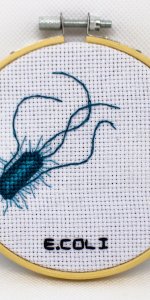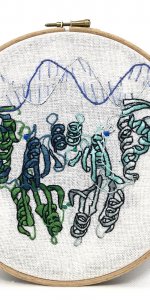13 January 2021
#DrawnToGeoscience: Cross stitching science
Posted by Shane Hanlon
#DrawnToGeoscience is a series of posts by artists who draw about science and explain their process and inspiration while also showcasing their pieces. Learn more about contributing. This week, Charlotte Roughton.

DNA. Credit: Charlotte Roughton
I’ve always enjoyed art and exercising my creativity. Although I chose a career in science – studying Biomedical Sciences, followed by a research Master’s and currently my PhD in Microbiology, art is a vital component of my self-care routine. It helps me unwind, but is also highly rewarding with an end product that I’m proud of.
It took some time to settle on a medium – I’ve dabbled in drawing, painting, needle felting, among others, but none of them really stuck. My Mum has been an avid cross stitcher for years, and I was interested in giving it a go. She taught me everything she knew, kindly allowing me to steal her hoops, fabric, and threads, and something about it just clicked. The process of cross stitching is so relaxing for me – being quite an anxious person, my mind is often ruminating on the past, or worrying about the future. Cross stitching brings my focus to the present moment and keeps it there – it’s methodical and repetitive, which I find incredibly soothing.
For a long time, the patterns I followed were ones that other people had made. I was intrigued by the process of making patterns, especially as my cross stitch interests began to swing towards more niche science-themed pieces, for which there were fewer patterns available. I discovered the software WinStitch, which allows you to draw up your own patterns, or even generate a pattern automatically from an imported image, with an export feature to generate a PDF with the pattern and floss legends.
I started to design my own patterns, either drawing them from scratch or consulting papers with microscopy imagery of microorganisms for inspiration. At this point, I opened my Etsy shop, stitchingscience, and started to sell the patterns that I had also been designing for my own use. They’ve proven to be reasonably popular, and I’m pleased to have helped contribute towards the small niche that is science cross stitch!
Since learning how to design my own patterns, I’ve undertaken several projects. One of my favourites, which really helped to wile away the time spent in lockdown this year, has been my microbiology alphabet. I’m endlessly fascinated by the microbial world, and this alphabet was my way of acknowledging this – it includes the pathogenic microorganisms that cause us harm, the beneficial microorganisms that we rely on to produce food and grow crops, the fundamental techniques that are used to help us understand the microbial world, and much more!
Another favourite piece of mine was an ode to my Master’s project. It was my first attempt at dabbling in embroidery, and I made the structure of a transcriptional regulator in the human pathogen Helicobacter pylori, HpNikR, which my research was focused on. This was a gift for my supervisor, who was integral in instilling confidence in me to pursue a PhD.
All in all, cross stitching has been essential in communicating my love for science in a creative way, while also offering a productive means by which to relax and unwind.
-Charlotte Roughton is a biosciences PhD student at Newcastle University. Find her on Twitter @cgroughton.














 The Plainspoken Scientist is the science communication blog of AGU’s Sharing Science program. With this blog, we wish to showcase creative and effective science communication via multiple mediums and modes.
The Plainspoken Scientist is the science communication blog of AGU’s Sharing Science program. With this blog, we wish to showcase creative and effective science communication via multiple mediums and modes.